Contact Improvisation is based on the communication between two or more bodies established through physical contact. The practice requires specific skills to establish and maintain a physical dialogue through an ever changing point of physical contact.
Experiential awareness of the physical laws of motion: gravity, inertia and momentum are key to safe and exploitative practice. By analysing the duet between Martin Keogh and Ray Chung (link below) describe what you see in terms of giving and taking weight, directing impulses, initiating movement and directing mass. Through this analysis draw conclusions about internal architecture, content and form of the practice.
In this essay I am going to talk about Martin Keogh’s and Ray Chung’s improvisation. I will look at the key elements of contact improvisation such as the giving and taking of weight, how they directing impulses, how they initiate movement and how they direct their mass. “Contact Improvisation is a rapidly growing dance form which centres around the movement of bodies in contact and their relationship to the physical laws which govern their motion: mass, gravity, momentum, and inertia.”(Siddall, 1976-77, 11) I will also see how gravity, momentum and inertia have a role in improvisation and what effect they have. Contact Improvisation is “A dance form that uses movement, gravity and their relationship to each other as revealed though changing points of balance.” (Curtis and Ptashek, 1988, 158)
In the performance by Keogh and Chung they are constantly changing weight and taking and giving each other’s weight. “Taking weight across one another’s back and hips, counter-balancing through the extension and grip of each other’s arms and hands, slowly stretching and releasing tension from muscle and joints.”(Curtis and Ptashek, 1988, 161)
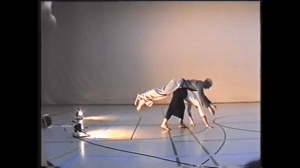 As you can see from the picture Chung takes Keogh weight. Chung becomes a stable base and uses his back to create a place for Keogh to balance on. Keogh has given his weight and is fully trusting of Chung. In a fluid motion Keogh rolls off the back and moves for Chung to then give his weight to Keogh. Keogh is directing his mass towards a natural position of standing. In this small section of the dance Keogh initiates the movement by directing his mass off of Chung’s back, he drops his leg to move off of Chung’s back but in the process grabs Chung’s leg and starts the next movement. This is giving and taking weight between both of them continuously. Another way in which movements were initiated was by Chung lifting his arm up. He is inviting Keogh and Keogh accepts by leaning in and hooking around Chung ready to lift. Throughout the performance they transfer their weight between each other however Chung is primarily the one lifted in the piece. In one part of the performance Chung jumped and expected Keogh to take his weight, Keogh was not expecting this and did not catch Chung. In Contact Improvisation it is crucial to have a connection with your partner and for you to know if your partner is ready to take your weight. “Another way to define center of gravity is the point around which the body is perfectly balanced.”(Woodhull, 1978-79, 43) When working in a duet both bodies have to work together to find the center of gravity within both bodies to balance and sustain the lift. The pelvis is the hub of the body and is where the centre of gravity is within the body. “In CI, we purposely change center of gravity in order to move” (Woodhull, 1978-79, 47) Keogh and Chungs centre of gravity is constantly moving and changing. Keogh and Chung comes to a stillness within the piece where Chung is wrapped around Keogh waist. They form a stillness where all areas of Contact are working in sync. This stillness is interesting and unusual compared to how the flow and fluidity of their piece was. The stillness made the audience stop within themselves.
As you can see from the picture Chung takes Keogh weight. Chung becomes a stable base and uses his back to create a place for Keogh to balance on. Keogh has given his weight and is fully trusting of Chung. In a fluid motion Keogh rolls off the back and moves for Chung to then give his weight to Keogh. Keogh is directing his mass towards a natural position of standing. In this small section of the dance Keogh initiates the movement by directing his mass off of Chung’s back, he drops his leg to move off of Chung’s back but in the process grabs Chung’s leg and starts the next movement. This is giving and taking weight between both of them continuously. Another way in which movements were initiated was by Chung lifting his arm up. He is inviting Keogh and Keogh accepts by leaning in and hooking around Chung ready to lift. Throughout the performance they transfer their weight between each other however Chung is primarily the one lifted in the piece. In one part of the performance Chung jumped and expected Keogh to take his weight, Keogh was not expecting this and did not catch Chung. In Contact Improvisation it is crucial to have a connection with your partner and for you to know if your partner is ready to take your weight. “Another way to define center of gravity is the point around which the body is perfectly balanced.”(Woodhull, 1978-79, 43) When working in a duet both bodies have to work together to find the center of gravity within both bodies to balance and sustain the lift. The pelvis is the hub of the body and is where the centre of gravity is within the body. “In CI, we purposely change center of gravity in order to move” (Woodhull, 1978-79, 47) Keogh and Chungs centre of gravity is constantly moving and changing. Keogh and Chung comes to a stillness within the piece where Chung is wrapped around Keogh waist. They form a stillness where all areas of Contact are working in sync. This stillness is interesting and unusual compared to how the flow and fluidity of their piece was. The stillness made the audience stop within themselves.
Chung and Keogh are different heights and weights however this does not matter in Contact Improvisation. Height and weight do not have a major role when performing in the duet. Some movements can become more difficult as Chung is smaller and lighter he is lifted more as it is easier. However Chung does take the weight of Keogh in places but does not really lift Keogh in the way which Keogh lifts Chung. “When someone reaches to grab me and lift me up and I don’t want to be lifted, I can drop my weight and move my center away from my partner’s center. I become too heavy to lift. I have clearly said no.”(Keogh, 2003, 274) If the partner still tries to lift the mass if too heavy to lift and would look disjointed not to mention hard for the lifter. It is important when being lifted to no drop your weight and keep your centre study unless you want to say no.
During the piece I noticed that Keogh used Aikido rolls throughout the piece. He did these over Chung creating excitement within the performance. It also changed the direction that they were dancing by doing this Keogh was initiating change within the piece.
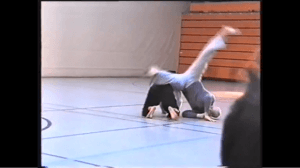 When giving or taking weight gravity has a major roll. If your partner can not take your weight or has not invited you for them to take your weight gravity will pull you down. The centre of gravity within the body also affects the lifts.“The center of gravity can move around 6 or 8 inches from its standard position in the body-not a huge distance, but enough to make a difference. Because the head and torso are so heavy (being about 55% of the total weight of most people), the center of gravity tends to stay around the belly.”(Woodhull, 1978-79, 45)If one person tests how far they can push their centre of gravity this could affect the movement. The movement would start to pull towards the ground resulting in a dancer being dropped.
When giving or taking weight gravity has a major roll. If your partner can not take your weight or has not invited you for them to take your weight gravity will pull you down. The centre of gravity within the body also affects the lifts.“The center of gravity can move around 6 or 8 inches from its standard position in the body-not a huge distance, but enough to make a difference. Because the head and torso are so heavy (being about 55% of the total weight of most people), the center of gravity tends to stay around the belly.”(Woodhull, 1978-79, 45)If one person tests how far they can push their centre of gravity this could affect the movement. The movement would start to pull towards the ground resulting in a dancer being dropped.
“In Contact Improvisation we work on overcoming the fear and disorientation associated with rolling, falling and jumping; and on allowing duets to develop from sharing weight and points of physical contact. Lifts and falls evolve out of a continuous process of finding and losing balance, of yielding and resisting.” (Walker, 2014) In this section Chung would have felt disorientation as he is upside down. Keogh had to keep walking forward and backwards to keep his balance with Chung on him. Keogh had to direct his mass in way he could to keep balance and not drop his partner.Throughout the piece Chung seemed to initiate the lifts, he threw himself at Keogh which created the lifts. The lifts were effortless and fluid. “In Contact Improvisation I learned through momentum how movement continues and can keep going almost indefinitely, as the senses do and energy does and one thing leads to the next, and there is always something going on.”(Nancy, 1993, 12)
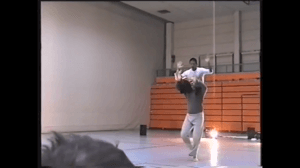 Momentum was crucial in this lift as Chung had to keep rolling and changing weight for get to Keogh shoulders. Keogh also had to keep his balance as well as be a support for Chung. Momentum was used throughout all of their lifts. Keogh and Chung used momentum to get Chung so high. Chung initiated this lift by lifting his arm up this lead Keogh in to putting his head in the gap which meant Chung could hook around Keogh body. Chung invited Keogh with the lifting of the arm and he said yes.
Momentum was crucial in this lift as Chung had to keep rolling and changing weight for get to Keogh shoulders. Keogh also had to keep his balance as well as be a support for Chung. Momentum was used throughout all of their lifts. Keogh and Chung used momentum to get Chung so high. Chung initiated this lift by lifting his arm up this lead Keogh in to putting his head in the gap which meant Chung could hook around Keogh body. Chung invited Keogh with the lifting of the arm and he said yes.
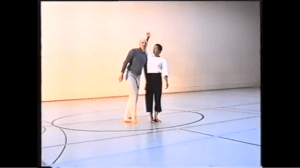 Common movements which initiate new movements are flat back and the tuck position. Throughout Keogh and Chung use both of these to create new movements. At one point Keogh tucks up on the floor and Chung simply lays on his back and plays with his head using his hand. The stillness was a dynamic change from previous movements as the piece had been fast and fluid with lots of momentum.
Common movements which initiate new movements are flat back and the tuck position. Throughout Keogh and Chung use both of these to create new movements. At one point Keogh tucks up on the floor and Chung simply lays on his back and plays with his head using his hand. The stillness was a dynamic change from previous movements as the piece had been fast and fluid with lots of momentum.
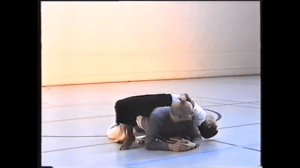 Throughout the improvisation Keogh and Chung lost and gained contact. “Making, breaking and maintaining contact are three of the basic acts of contact.”(Wonder, 2003, 246) One experimental moment within the Improvisation where they broke contact but they still had a sense of contact. Chung controlled Keogh in a puppet like manner. This was exciting and different in the piece.
Throughout the improvisation Keogh and Chung lost and gained contact. “Making, breaking and maintaining contact are three of the basic acts of contact.”(Wonder, 2003, 246) One experimental moment within the Improvisation where they broke contact but they still had a sense of contact. Chung controlled Keogh in a puppet like manner. This was exciting and different in the piece.
Chung in one section had to keep his rotational inertia when Keogh lifted him. Chung was constantly rolling around Keogh’s body. The rolling lead into an exciting lift of continuous movement around Keogh. Chung and Keogh made look easy and effortless. Hung and Keogh throughout never tried to do something they couldn’t. There was a moment when Keogh was not prepared for Chung but also when Chung knocked Keogh and he hit his face. They never pushed their bodies past a limit. “Peter Ryan suggested that contact improvisation shows you the ‘difference between your real body and your idealized body’ by asking what your body can do, not what you make it do.” (Novak, 1990, 181) It was clear that both dancers asked what their bodies could do and never pushed past limitations they had. The body is crucial in contact improvisation and more importantly touch. “Vital information about the direction and quality of the dance exchanges through this dynamic touch site. Here information about weight, energy, strength, balance, and sensitivity relays back and forth between partners.” (Pallant, 2006, 22) Touch is the communication tool in contact improvisation as the dancers cannot talk or set choreography.
From Keogh and Chung’s improvisation they use all the key elements of contact improvisation but are willing to experiment and create new and exciting movements. They work with gravity and momentum to create fluid movements in and out of lifts. There improvisation shows what contact improvisation is and how it is an art form. They also prove that height and weight of your partner does not matter and should affect the quality of the piece. Keogh and Chung show how easy it is to exchange weight across the floor and to stay in contact but they also showed there can be moments where contact it lost and different types of contact can be found. This creates exciting and new movements. Overall Keogh and Chung experimented within this Improvisation and it worked. They showed stillness, noncontact and fluidity with the improvisation. The constant changing of weight, gravity, mass and inertia showed.
Reference List
Curtis, B. and Ptashek, A. (1988) Exposed to Gravity, 13 158, 161.
Siddall, C. (1976-77) Bodies in Contact. 2, 11.
Keogh, M. (2003) 101 ways to say no to Contact Improvisation, 28:2, 274
Nancy. (1993) what goes up, 18:2, 12.
Novak, C. (1990) Sharing the Dance, United States: University of Wisconsin Press.
Pallant, C. (2006) Contact Improvisation: An Introduction to Vitalizing Dance Form, United States: McFarland and Company, Incorpated Publishers.
Walker, L. (2014) Direction A journal on Alexander Technique. [Online] Available from: http://www.directionjournal.com/engl-22/ [Accessed 8 December 2014].
Woodhull, A. (1978-79) Center of Gravity, 4, 43, 45, 47.
Wunder, A. (2003) In and Out of Contact, 28:1, 246.
Accessed on 8 December 2014: http://vimeo.com/40556983